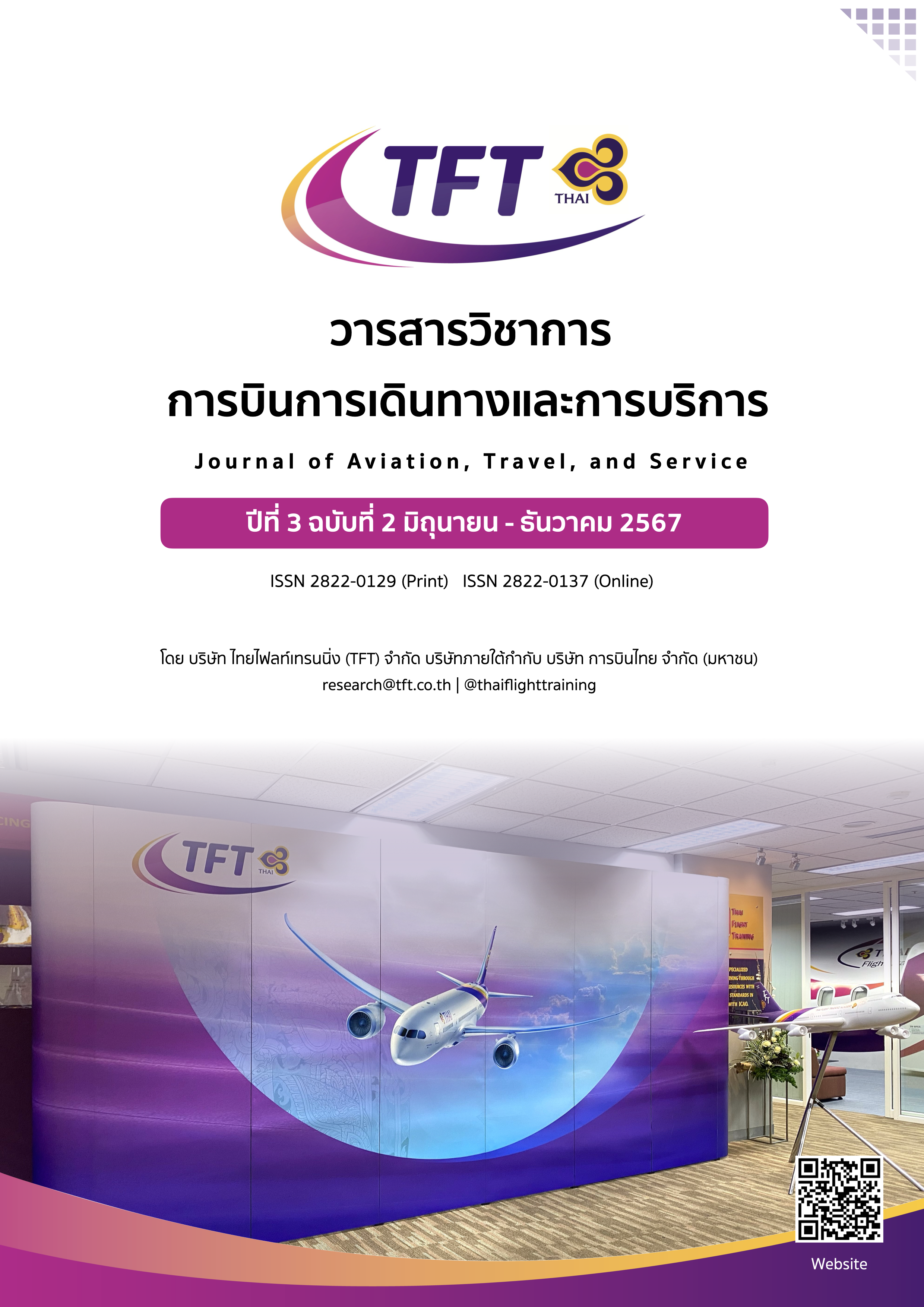The Learning for the Future Workforce Through Digital Innovation
Keywords:
Future Workforce, Digital Innovation, Virtual Reality TechnologyAbstract
This qualitative research aimed to 1) specify virtual reality technology's quality characteristics and reinforcement factors in transformative learning of higher education that supports students' learning ability and 2) understand virtual reality technology's role in shaping attitude and behavior based on pedagogical values through intrinsic motivation that enhances students' learning performance and satisfaction. The data were gathered and utilized using focus group discussions and observation methods from 36 undergraduate students in their second and third year at the College of Aviation Development and Training, Dhurakij Pundit University, who all were key informants. The result indicated that applying virtual reality technology as a tool to bridge new educational challenges in response to the Thai higher education reform policy to leverage the country's workforce competency level helps researchers understand the importance of positive reinforcement in 3 areas that are 1) stimulation and motivation for learning 2) promoting understanding during learning and 3) building confidence in the learning outcomes. While digital innovation plays an essential role in shaping the future of education, ensuring that new teaching tools are used effectively will require a new generation of educators who understand the importance of students' connection in the classroom. Moreover, the research results also help deepen the researchers' understanding of the role of digital technology innovation in increasing students' perceptions. The pragmatic quality and the hedonic quality indicators were found to enhance the linkages of the learning transformation process towards the learners' development of behavior, attitudes, and beliefs that promote their competencies to a higher level.
References
Abele, Andrea E., and Daniel Spurk. (2009). The Longitudinal Impact of Self-Efficacy and Career Goals on Objective and Subjective Career Success. Journal of Vocational Behavior, 74(1), 53–62. doi.org/10.1016/j.jvb.2008.10.005
Bandura, A. (1977). Self-efficacy: Toward a unifying theory of behavioral change. Psychological Review, 84(2), 191-215. https://doi.org/10.1037/0033-295X.84.2.191
Bandura, A. (1999). A social cognitive theory of personality. In L. Pervin & O. John (Eds.), Handbook of personality (2nd ed., pp. 154-196). Guilford Publications. (Reprinted in D. Cervone & Y. Shoda (Eds.), The coherence of personality, pp. 154-196). Guilford Press.
Bandura, A. (1999). A social cognitive theory of personality. In L. Pervin & O. John (Eds.), Handbook of personality (2nd ed., pp. 154-196). Guilford Publications.
Dollard, J., & Miller, N. E. (1950). Personality and Psychotherapy: An Analysis in Terms of Learning, Thinking, and Culture. McGraw-Hill. https://doi.org/10.1177/004057365100800323
Gachago, D., Bozalek, V., & Ng'ambi, D. (2013). Transforming teaching with emerging technologies: Implications for higher education institutions. South African Journal of Higher Education, 27(2), 419-436.
Glaser, R. (Ed.). (1962). Training research and education. Columbia University Press.
Glaser, R. (1962). Programed instruction — A behavioral view. American Behavioral Scientist, 6(3), 46–51. https://doi.org/10.1177/000276426200600313
Gudoniene, D., & Rutkauskiene, D. (2019). Virtual and Augmented Reality in Education. Baltic Journal of Modern Computing, 7. https://doi.org/10.22364/bjmc.2019.7.2.07
Hughes, T. (1989). The evolution of large technological systems. In W. E. Bijker, T. P. Hughes, & T. J. Pinch (Eds.), The social construction of technological systems: New directions in the sociology and history of technology (pp. 51-82). MIT Press.
Lizzio, A., Wilson, K., & Simons, R. (2002). University Students' Perceptions of the Learning Environment and Academic Outcomes: Implications for Theory and Practice. Studies in Higher Education, 27, 27–52. https://doi.org/10.1080/03075070120099359
Maddux, J. E. (2002). Self-efficacy: The power of believing you can. In C. R. Snyder & S. J. Lopez (Eds.), Handbook of positive psychology (p. 277–287). Oxford University Press.
Mamatha, S. M. (2021). Experiential learning in higher education. International Journal of Advance Research and Innovation, 9(3), 1-9. https://doi.org/10.51976/ijari.932101
Mezirow, J. (1991). Transformative Dimensions of Adult Learning. Jossey-Bass Publishers.
Miettinen, R. (2000). The concept of experiential learning and John Dewey's theory of reflective thought and action. International Journal of Lifelong Education, 19(1), 54–72. https://doi.org/10.1080/026013700293458
Mills, K., Jass Ketelhut, D., & Gong, X. (2019). Change of Teacher Beliefs, But Not Practices, Following Integration of Immersive Virtual Environment in the Classroom. Journal of Educational Computing Research, 57(7), 1786-1811.
Ngiik Hoon, L., & Shaharuddin, S. (2019). Learning Effectiveness of 3D Hologram Animation on Primary School Learners. Journal of Visual Art and Design, 11, 93-104.
Ochoa, C. J. (2016). Virtual reality and augmented reality in education. Are we ready for a disruptive innovation in education? In 9th annual International Conference of Education, Research and Innovation (pp. 2013-2022). Seville, Spain. https://doi.org/10.21125/iceri.2016.1454
Raven, J. & Stephenson, J. (2021). Competence in the Learning Society. Peter Lang.
Rogers, E. M. (1983). Diffusion of innovations (3rd ed.). The Free Press.
Ryan R. M., Deci E. L. (1985). Intrinsic Motivation and Self-Determination in Human Behavior.
Plenum Press. http://dx.doi.org/10.1007/978-1-4899-2271-7
Ryan, R. M., & Deci, E. L. (2000). Intrinsic and extrinsic motivations: Classic definitions and new directions. Contemporary Educational Psychology, 25(1), 54–67. https://doi.org/10.1006/ceps.1999.1020
Schlindwein, L., Hounsell, M., & Kemczinski, A. (2013). A comparative study on two aspects that influence the sense of presence in virtual environments. Revista Brasileira de Computação Aplicada, 5(1), 113–125. https://doi.org/10.5335/rbca.2013.2816
Seligman, M. (1998). Building human strength: psychology's forgotten mission. APA Monitor. 29, 2.


